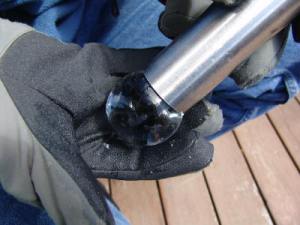Wilderness Survival- How to Make Fire From Ice







Now for the magic!
By taking a tube, and rubbing it over the surface of the rough sphere, we start to cut/polish away at any irregularities.
As Nelson pointed out, with this technique, "you can't go wrong." If you use a true random motion in the polishing, then you have no choice but to make a perfect sphere!






The biggest problem with ice lenses so far has been the ability to make a lens that has a tight enough focal point to light tinder. There was always the trade-off between the quality of the lens and the size of the lens. To compound this problem, if we needed to make a big lens, then we needed a big piece of ice. As described in the first fire-by-ice articles, getting clear ice isn't very easy.
With this tube-polishing technique a number of new avenues have been opened:
1) We only need a small piece of clear ice - which is much easier to find and/or create. In the above photos, where the smallest sphere was made, the starting point was something that looked a lot like an icicle. Very often, icicles are perfectly clear - and they're easy-pickin in the winter. The icicles are already in an almost cylindrical shape - so much of the work is already done! An icicle provides: clear material, a hand-hold, is partially preformed, and is on display. Wow, what a starting point!
2) Since this tube-polishing technique guarantees a perfect sphere - we have removed much of the skill element to this technique. The better the original roughed-out sphere, the less polishing required. A very poor original sphere will still end up being perfect, one just needs to polish longer.
There is still exploration that can go into sources for the tube. A longer tube is nice, since it is easy to hold. I also tried various sized "rings" and they also worked well. One could also use a sheet of material with a circular hole in it. Other natural materials might include: coconut shells, sea shells, nut shells etc.
The cutting edge on the tools can also be optimized. Maybe a serrated edge for the rough polishing, and then the hook-edge/burnish for the final polish. In a survival situation, one could use cans, jars, lids, pieces of pipe, rings, bracelets etc. - wildwoodsurvival













1 comment:
Very interesting post. Great tips but don't forget your knowledge and in the outdoors Wilderness Survival Skills are a big part of that knowledge.
Post a Comment